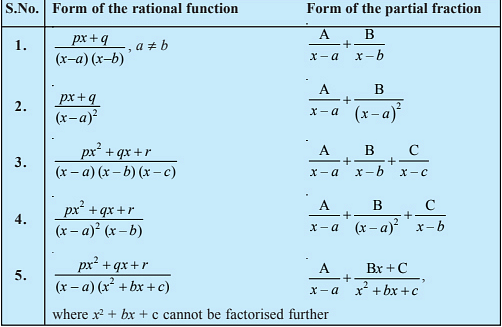Integrate the function: \(\frac {1}{(x^2+1)(x^2+4)}\)
Solution and Explanation
∴\(\frac {1}{(x^2+1)(x^2+4)}\) = \(\frac {Ax+B}{(x^2+1)}+\frac {Cx+D}{(x^2+4)}\)
\(⇒1 = (Ax+B)(x^2+4)+(Cx+D)(x^2+1)\)
\(⇒1 = Ax^3+4Ax+Bx^2+4B+Cx^3+Cx+Dx^2+D\)
Equating the coefficients of \(x^3,x^2,x,\) and constant term,we obtain
\(A+C=0\)
\(B+D=0\)
\(4A+C=0\)
\(4B+D=1\)
On solving these equations, we obtain
\(A=0,\ B=\frac 13,\ C=0,\ D=-\frac 13\)
From equation(1), we obtain
\(\frac {1}{(x^2+1)(x^2+4)}\) = \(\frac {1}{3(x^2+1)}-\frac {1}{3(x^2+4)}\)
\(∫\)\(\frac {1}{(x^2+1)(x^2+4)}\) = \(\frac 13∫\frac {1}{x^2+1}dx-\frac {1}3∫\frac {1}{x^2+4}dx\)
=\(\frac 13\tan^{-1}x-\frac 13.\frac 12tan^{-1}\frac x2+C\)
=\(\frac 13tan^{-1}x-\frac 16tan^{-1}\frac x2+C\)
Top Questions on integral
Let \( f : (0, \infty) \to \mathbb{R} \) be a twice differentiable function. If for some \( a \neq 0 \), } \[ \int_0^a f(x) \, dx = f(a), \quad f(1) = 1, \quad f(16) = \frac{1}{8}, \quad \text{then } 16 - f^{-1}\left( \frac{1}{16} \right) \text{ is equal to:}\]
- Let $ f(x) $ be a positive function and $I_1 = \int_{-\frac{1}{2}}^1 2x \, f\left(2x(1-2x)\right) dx$ and $I_2 = \int_{-1}^2 f\left(x(1-x)\right) dx.$ Then the value of $\frac{I_2}{I_1}$ is equal to ____
- The value of the definite integral \( \int_0^{\pi} \sin^2 x \, dx \) is:
- Evaluate the integral: \[ \int \frac{\sin(2x)}{\sin(x)} \, dx \]
- Find the value of the integral: \[ \int_0^\pi \sin^2(x) \, dx. \]
Questions Asked in CBSE CLASS XII exam
- Observe the graph in the given figure and answer the following questions:

(a) Predict the order of reaction.
(b) What is the slope of the curve?- CBSE CLASS XII - 2025
- Chemical Kinetics
- If \( \overrightarrow{a} + \overrightarrow{b} + \overrightarrow{c} = 0 \), \( |\overrightarrow{a}| = \sqrt{37} \), \( |\overrightarrow{b}| = 3 \), and \( |\overrightarrow{c}| = 4 \), then the angle between \( \overrightarrow{b} \) and \( \overrightarrow{c} \) is:
- Two infinitely long straight wires ‘1’ and ‘2’ are placed \(d\) distance apart, parallel to each other, as shown in the figure. They are uniformly charged having charge densities \(\lambda\) and \(-\frac{\lambda}{2}\) respectively. Locate the position of the point from wire ‘1’ at which the net electric field is zero and identify the region in which it lies.

- CBSE CLASS XII - 2025
- Electrostatics
How do the peddler from ‘The Rattrap’ and ‘the office boy’ from ‘Poets and Pancakes’ compare in terms of their frustration, status, and grudges against others?
- Mention the fitness index score formula and its norms for the Harvard Step Test.
- CBSE CLASS XII - 2025
- Physical Fitness Testing
Concepts Used:
Integration by Partial Fractions
The number of formulas used to decompose the given improper rational functions is given below. By using the given expressions, we can quickly write the integrand as a sum of proper rational functions.

For examples,
